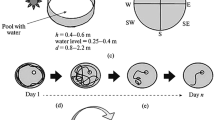Abstract
The Morris water maze is the basic test to study spatial learning and memory in laboratory rodents. It is part of the set of tests necessary for behavioral phenotyping of mutant and transgenic mice. However, the SPF conditions impose very strict regulations on pathogen control, which hinders performance of this test. Another problem is a low contrast of a white animal on the whitened water surface, interfering with automated animal tracking. A unique installation based on EthoStudio has been designed at the Institute of Cytology and Genetics, Siberian Branch, Russian Academy of Sciences and Institute of Automation and Electrometry, Siberian Branch, Russian Academy of Sciences. This tool automates the tracking of mice of any coat color under SPF conditions and comprises a plastic water tank (110 × 40 cm), a digital camera, and a light source. The water for the tank is sterilized using a Van Erp Blue Lagoon UV-C Tech 15000 ultraviolet decontaminator. The image of an animal is processed in a frame-by-frame manner using the EthoStudio software; the following parameters are calculated: escape latency, path length, cumulative distance to the platform, and the time spent in the sectors of tank. This installation has allowed us to study the spatial learning and memory in C57BL/6 and C57BL/6/Kaiso mice; in the latter strain, the gene encoding the methyl-DNA binding Kaiso protein is knocked out. It has been shown that the mice of these strains are capable of learning to find the platform in the Morris water maze and remember the location of the platform for at least the next four days.
Similar content being viewed by others
References
Blaha, G.R., Raghupathi, R., Saatman, K.E., and McIntosh, T.K., Brain-derived neurotrophic factor administration after traumatic brain injury in the rat does not protect against behavioral or histological deficits, Neuroscience, 2000, vol. 99, pp. 483–493.
Cirulli, F., Berry, A., and Alleva, E., Intracerebroventricular administration of brain-derived neurotrophic factor in adult rats affects analgesia and spontaneous behavior but not memory retention in a Morris water maze task, Neurosci. Lett., 2000, vol. 287, pp. 207–210.
Cirulli, F., Berry, A., Chairotti, F., and Alleva, E., Intrahippocampal administration of BDNF in adult rats affects short-term behavioral plasticity in the Morris water maze and performance in the elevated plus-maze, Hippocampus, 2004, vol. 14, pp. 802–807.
Crawley, J.N., Behavioral phenotyping strategies for mutant mice, Neuron, 2008, vol. 57, pp. 809–818.
D’Hoodge, R. and De Deyn, P.P., Applications of the Morris water maze in the study of learning and memory, Brain Res., 2001, vol. 36, pp. 60–90.
Dalm, S., Grootendorst, J., de Kloet, E.R., and Oitzl, M.S., Quantification of swim patterns in the Morris water maze, Behav. Res. Meth. Instrum. Comput., 2000, vol. 32, pp. 134–139.
Dalm, S., Schwabe, L., Schachinger, H., and Oitzl, M.S., Post-training self administration of sugar facilitates cognitive performance of male C57BL/6J mice in two spatial learning tasks, Behav. Brain Res., 2009, vol. 198, pp. 98–104.
Derdikman, D. and Moser, E.I., A manifold of spatial maps in the brain, Trends Cogn. Sci., 2010, vol. 14, pp. 561–569.
Gallagher, M., Burwell, R., and Burchinal, M., Severity of spatial learning impairment in aging: Development of a learning index for performance in the Morris water maze, Behav. Neurosci., 1993, vol. 107, pp. 618–626.
Khotskin, N.V., Fursenko, D.V., Bazovkina, D.V., Kulikov, V.A., and Kulikov, A.V., Automatic measurement of spatial learning performance of mice in the Morris water maze test with reversed lighting, Ross. Fiziol. Zh. im. I.M. Sechenova, 2014, vol. 100, pp. 36–44.
Korostina, V.S. and Kulikov, A.V., Behavioral phenotyping of Kaiso gene knockout mice, Vavilovskii Zh. Genet. Sel., 2015, vol. 19, no. 4, pp. 399–403. doi 10.18699/VJ15.01
Kulikov, V.A., Kirichuk, V.S., Tikhonova, M.A., and Kulikov, A.V., The use of probability density for automating the spatial preference assay in ethological experiments, Dokl. Akad. Nauk, 2007, vol. 417, no. 1, pp. 442–445.
Kulikov, A.V., Tikhonova, M.A., and Kulikov, V.A., Automated measurement of spatial preference in the open field test with transmitted lighting, J. Neurosci. Meth., 2008, vol. 170, pp. 345–351.
Kulikov, A.V., Fursenko, D.V., Khotskin, N.V., Bazovkina, D.V., Kulikov, V.A., Naumenko, V.S., Bazhenova, E.Y., and Popova, N.K., Spatial learning in the Morris water maze in mice genetically different in the predisposition to catalepsy: The effect of intraventricular treatment with brain-derived neurotrophic factor, Pharmacol. Biochem. Behav., 2014, vol. 122, pp. 266–272.
Moser, E. and Moser, M.B., Mapping your every move, Cerebrum, 2014, vol. 2014, p. 4.
Moser, M.B., Rowland, D.C., and Moser, E.I., Place cells, grid cells, and memory, Cold Spring Harb. Perspect. Med., 2015, vol. 7, no. 2.
Naumenko, V.S., Kondaurova, E.M., Bazovkina, D.V., Tsybko, A.S., Ilchibaeva, T.V., Khotskin, N.V., Semenova, A.A., and Popova, N.K., Effect of GDNF on depressive-like behavior, spatial learning and key genes of the brain dopamine system in genetically predisposed to behavioral disorders mouse strains, Behav. Brain Res., 2014, vol. 274, pp. 1–9.
Noldus, L.P.J.J., Spink, A.J., and Tegelenbosch, R.A.J., EthoVision: A versatile video tracking system for automation of behavioral experiments, Behav. Res. Meth. Instr. Compt., 2001, vol. 33, pp. 398–414.
Spink, A.J., Tegelenbosch, R.A.J., Buma, M.O.S., and Noldus, L.P.J.J., The EthoVision video tracking system–a tool for behavioral phenotyping of transgenic mice, Physiol. Behav., 2001, vol. 73, pp. 731–744.
Tandon, P., Yang, Y., Das, K., Holmes, G.L., and Stafstrom, C.E., Neuroprotective effects of brain-derived neurotrophic factor in seizures during development, Neuroscience, 1999, vol. 91, no. 1, pp. 293–303.
Yoon, H.G., Chan, D.W., Reynolds, A.B., Qin, J., and Wong, J., N-CoR mediates DNA methylation-dependent repression through a methyl CpG binding protein Kaiso, Mol. Cell, 2003, vol. 12, no. 3, pp. 723–734.
Author information
Authors and Affiliations
Corresponding author
Additional information
Original Russian Text © N.V. Khotskin, V.A. Kulikov, E.L. Zavyalov, D.V. Fursenko, A.V. Kulikov, 2015, published in Vavilovskii Zhurnal Genetiki i Selektsii, 2015, Vol. 19, No. 4, pp. 388–393.
Rights and permissions
About this article
Cite this article
Khotskin, N.V., Kulikov, V.A., Zavyalov, E.L. et al. Conducting and automating Morris water maze test under SPF conditions. Russ J Genet Appl Res 6, 394–399 (2016). https://doi.org/10.1134/S2079059716040092
Received:
Accepted:
Published:
Issue Date:
DOI: https://doi.org/10.1134/S2079059716040092




